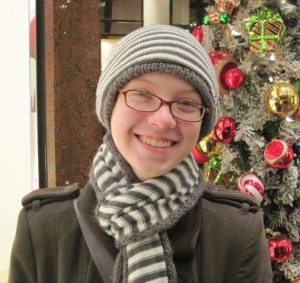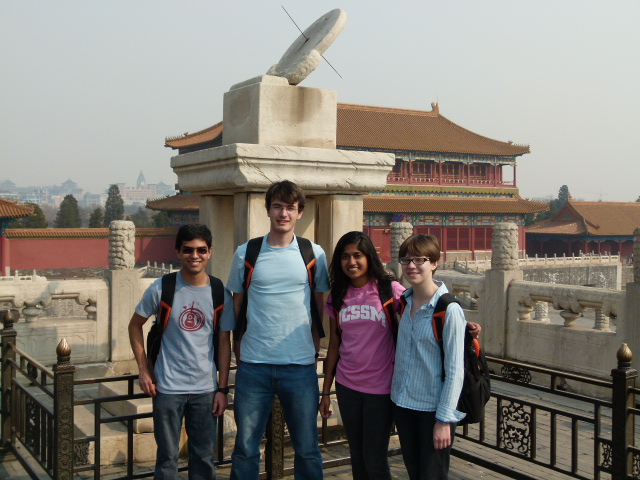 Alyssa Ferris is a sixteen year old student at the North Carolina School of Science and Mathematics in Raleigh, NC. In 2011 Alyssa worked with Dr. Beth Sullivan at Duke University on her project, The effect of epigenetic modifications on active and inactive centromeres. She was selected as an Intel Science Talent Search Semi-Finalist for her work on this project. Previously, Alyssa studied regulation of centromere localization with Dr. Judy Brown at the University of Connecticut and the genetic diversity of feral honey bee colonies with Dr. Deborah Delaney at North Carolina State University. She is a member of Sigma Xi, the scientific research society, and Women in Science and Engineering. In her free time, Alyssa enjoys reading philosophy and playing the banjo.
Alyssa Ferris is a sixteen year old student at the North Carolina School of Science and Mathematics in Raleigh, NC. In 2011 Alyssa worked with Dr. Beth Sullivan at Duke University on her project, The effect of epigenetic modifications on active and inactive centromeres. She was selected as an Intel Science Talent Search Semi-Finalist for her work on this project. Previously, Alyssa studied regulation of centromere localization with Dr. Judy Brown at the University of Connecticut and the genetic diversity of feral honey bee colonies with Dr. Deborah Delaney at North Carolina State University. She is a member of Sigma Xi, the scientific research society, and Women in Science and Engineering. In her free time, Alyssa enjoys reading philosophy and playing the banjo.
ALYSSA’S ABSTRACT:
Mentors: Dr. Beth Sullivan and Dr. Amy Sheck
The effect of epigenetic modifications on active and inactive centromeres
Most chromosomes have a single centromere, but some, called dicentrics, have two functional centromeres. This usually leads to cell death; in human dicentrics, however, one of the centromeres is turned off and the cell remains functional. To determine if the presence of histone methylation, (a mechanism for inactivation) correlated with centromeric function, I measured the levels of euchromatic and heterochromatic methylation at active and inactive centromeres of the naturally dicentric human Chromosome 17. I used four hybrid mouse cell lines, derived from two distinct human cell lines that had a different active centromere (either centromere Z1 or Z1B) on each homologous chromosome. To quantify the levels of histone methylation, I used chromatin immunoprecipitation to pull down DNA that was tagged with specific methylation groups and then measured the levels of methylation using semi-quantitative PCR. I found that the levels of heterochromatic methylation increased when centromere Z1 became inactive, but I did not find a similar trend at the other centromere (Z1B) or with euchromatic methylation. I also found that the levels of methylation were not constant in different cell lines, indicating that each cell line had a unique epigenetic profile instead of a set level of methylation. These results have long term implications for cancer medications and gene therapy.
ALYSSA’S UPDATES FROM BEIJING:
March 23, 2012
Today we presented our posters to the judges. There were four asian judges who spoke varying degrees of English and two Caucasian judges. Most of the chinese judges understood the majority of our project descriptions, but one of them didn’t understand any of it, and Alan had to translate our projects. After being judged, we walked around and looked at the other projects. We also met some of the asian students who wanted to practice their English. Scarlet (after Gone with the Wind) talked to us and then showed us her social studies project which looked at how people prepare for BYSCC. The most impressive projects were in engineering. In particular, one boy designed a robot that draws a picture based on input from an excel program and another designed a plane that can take off from land or water.
March 22, 2012
This morning we went to the museum of natural history with the rest of the foreign delegates. Most of the exhibits that we went through had different types of specimens set up in different environments. However, the only part that was translated was the Latin names, so we kept trying to guess what the animals were. The other exhibit we saw was about human anatomy which was notable because of the path of sperm stickers on the floor and the debatably real human fetuses showing how embryos development over time.
In the afternoon we went to the school to set up our posters, and worked with Alan, one of our translators, to translate the titles and a project summary into mandarin. Next, we met the Australian delegation who eagerly enforced us about the dangers of the drop bear. This extremely dense animal injures 31.5 out of 125 people by dropping on them out of trees; apparently it’s a national joke that the Australian play on immigrants and tourists. We also looked some of the other projects by the Chinese students, especially the fantasy drawings that showed new inventions and the building models made out of toothpicks.
